LogiFlex - Get More by Using AI #
Introduction #
LogiFlex is a service specializing in the development of logistics algorithms for packaging goods in vehicles using laws and ideas that our AI finds. LogiFlex - Get More by Using AI! Check out our website - http://logiflex.ru
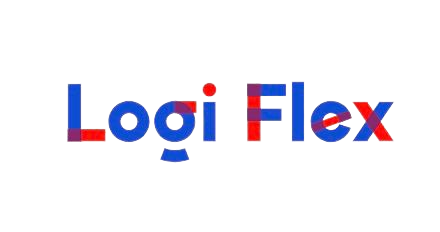
The project idea was so successful that the team managed to attract investments from interested investors immediately after its inception. Just nine days later, the project team successfully negotiated with the largest network of building materials in the Far East, securing payment for the development process, project delivery, and obtaining copyrights. This partnership aims to address the network’s own logistical problems and optimize their transport processes.
For collaboration inquiries or if you have any questions, feel free to reach out to me at: @GeorgiyBudnik (Team Lead)
Week One #
Progress report - Week 1 #
Agenda:
- Team Formation
- Problem statement
- Consideration of the business component of the project
Team Formation #
Our team was carefully selected based on their experience, participation, and wins in international Olympiads, competitions, and hackathons. We also reached out to the general student group to fill any missing positions required for the project. Within a day, we found the missing team member and smoothly started working.
| Team Member | Telegram ID | Email Address |
|---|---|---|
| Georgii Budnik (Lead) | @GeorgiyBudnik | g.budnik@innopolis.university |
| Vladislav Urzhumov | @V_Liker | v.urzhumov@innopolis.university |
| Igor Abramov | @IG_ragon | ig.abramov@innopolis.university |
| Ruslan Abdullin | @Fliegende_Rehe | ru.abdullin@innopolis.university |
Value Proposition #
The flagship project of the LogiFlex team aims to solve the problem of cargo distribution in limited space, ensuring optimal solutions for customers. It tackles multiple challenges in the field of logistics and cargo transportation that lack definitive solutions to date.
The customer benefits from the project by obtaining real-time information about the location and pricing of goods in any vehicle. Currently, the company employs a team of four or more logisticians responsible for manually placing goods in different trucks. This process is time-consuming and costly, involving computational resources, manual data processing, and the salaries of the logistics department.
Our project minimizes the company’s costs by replacing a significant part of the specialized department with a single programmer/logistician who monitors the algorithm’s correctness.
Lean Startup Questionnaire #
Please answer the following questions related to the lean startup methodology:
What problem or need does your software project address?
- The LogiFlex software project addresses the problem of cargo distribution in limited spaces, aiming to provide optimal solutions for customers. The current manual process of placing goods in different trucks is time-consuming and costly for the company. The project aims to automate and optimize this process, minimizing costs and improving efficiency.
Who are your target users or customers?
- The target users or customers of the LogiFlex software project primarily include logistics companies or businesses involved in cargo transportation and distribution. These may include freight forwarders, shipping companies, e-commerce platforms, manufacturers, and distributors who need efficient allocation and tracking of goods in limited space.
How will you validate and test your assumptions about the project?
- LogiFlex can validate and test its assumptions about the project through several methods:
- Conducting user interviews and surveys with logistics professionals to understand their pain points and gather feedback on the proposed solution.
- Building a prototype or minimum viable product (MVP) and conducting usability tests with target users to observe their interactions and gather insights.
- Running pilot tests with a select group of customers to validate the effectiveness and efficiency of the software in solving the identified problems.
- Collecting and analyzing data on key performance indicators (KPIs) such as time saved, cost reductions, and customer satisfaction levels.
- LogiFlex can validate and test its assumptions about the project through several methods:
What metrics will you use to measure the success of your project?
- The success of the project can be measured using various metrics, including:
- Reduction in manual processing time: Measure the time saved by automating cargo distribution and compare it with the previous manual process.
- Cost savings: Quantify the financial benefits achieved by minimizing the need for a specialized department and optimizing resource allocation.
- Accuracy and error rates: Track the algorithm’s accuracy in placing goods in trucks and monitor any errors or discrepancies.
- Customer satisfaction: Gather feedback from customers regarding their experience with the software, ease of use, and overall satisfaction with the solution.
- Adoption and retention rates: Monitor the number of customers using the software and track their continued usage over time.
- The success of the project can be measured using various metrics, including:
How do you plan to iterate and pivot if necessary based on user feedback?
- LogiFlex plans to iterate and pivot based on user feedback in the following ways:
- Regularly gather feedback from customers through surveys, user interviews, and support channels to understand their needs and pain points.
- Prioritize and analyze feedback to identify areas of improvement and address any issues or shortcomings in the software.
- Continuously release updates and new features based on customer feedback and evolving market demands.
- Conduct A/B testing or controlled experiments to test different approaches or variations of the software to optimize performance and user satisfaction.
- Stay agile and flexible in adapting the software based on user feedback, market trends, and emerging technologies to ensure the solution remains relevant and competitive.
- LogiFlex plans to iterate and pivot based on user feedback in the following ways:
Leveraging AI, Open-Source, and Experts #
Due to the wide variety of building materials available (with more than 10,000 different types of goods), using a standard algorithm for arranging goods in a truck becomes challenging. Each product has its own interaction requirements (e.g., a bag of cement cannot be placed on a sink, foam materials require special storage conditions, and floor coverings are transported in the form of rolls). To address this complexity, the LogiFlex team, in collaboration with the project customer, decided to employ Machine Learning (ML) and Artificial Intelligence (AI) methods to learn from a curated dataset and solve this problem.
The product development team will study articles related to logistical problem-solving, such as the use of genetic algorithms or sub-training techniques (more details to be discussed in the following weeks).
In collaboration with the customer, we have established twofold support, including building the dataset and resolving any conflicting issues during the solution. We have online communication access during working hours with the Head of the IT company, computing resources for AI algorithms, and partially assembled datasets (additional resources provided by movers, cargo vehicle drivers, and the current logistics department staff).
Inviting Other Students #
Our team currently consists of four second-year bachelor students from Innopolis University (The number of team members is agreed upon with Rustam Lukmanov). If required or if other students show interest in the project, we are open to involving them and providing compensation (possibly in the form of a salary). For example, Artem Batalov, a third-year bachelor student of Innopolis University, was involved in creating a LogiFlex business card site, as a DevOps specialist.
Defining the Vision for Your Project #
The vision of LogiFlex is to revolutionize cargo distribution in limited spaces by leveraging advanced algorithms and technology. Our flagship project aims to solve multiple challenges in logistics and optimize cargo transportation, providing customers with optimal solutions that were previously unavailable. By streamlining processes and reducing manual intervention, our project will significantly minimize costs for the company and deliver faster and more accurate information about the location and pricing of goods to our customers.
Problem and Need: #
The existing cargo distribution process at LogiFlex involves the manual placement of goods in trucks by a department consisting of logisticians. This process is time-consuming, resource-intensive, and prone to errors. By introducing automation and optimization, we aim to address these challenges and eliminate the need for a large specialized department. Our project will optimize cargo distribution in limited spaces, ensuring optimal solutions that meet customer criteria while reducing costs and improving efficiency.
Benefits and Impact: #
- Speed and Accuracy: Customers will experience faster and more reliable information about the location of their goods and associated pricing. This will enable them to make informed decisions and plan their operations efficiently.
- Cost Reduction: By automating the cargo distribution process, we will minimize costs for the company. This includes reducing computing power requirements, eliminating the need for a large team of logisticians, and streamlining data processing. These cost savings will be passed on to the customers, making LogiFlex a more competitive and cost-effective logistics provider.
- Operational Efficiency: Our project will streamline the entire cargo distribution process, leading to improved operational efficiency. By replacing manual processes with algorithms, we will eliminate human errors and reduce the time required for data processing and decision-making. This will enable LogiFlex to handle a larger volume of cargo, enhance customer satisfaction, and improve overall service quality.
Tech Stack: #
- Programming Language: Python. Python is a versatile and widely adopted language with extensive libraries and frameworks for data processing and algorithm development. Additionally, we need a programming language to visualize data and generate a final PDF file as a snapshot of the goods’ location.
- Algorithmic Framework: Machine Learning (ML) and Optimization Algorithms. We will utilize machine learning techniques to develop models that can learn from historical data and make predictions about cargo distribution in limited spaces. Optimization algorithms will be employed to find optimal solutions based on customer criteria and resource constraints.
- Infrastructure: Cloud Computing (e.g., Amazon Web Services or Microsoft Azure). Leveraging cloud computing services will offer scalability, high availability, and cost-effective infrastructure for hosting and running the system. The choice of the cloud provider will depend on factors such as cost, performance, and the team’s familiarity.
Anticipating Future Problems: #
- Data Availability: Obtaining accurate and comprehensive data for training the machine learning models might be challenging. To mitigate this, we will establish partnerships with relevant stakeholders.
- Algorithm Optimization: Developing efficient and accurate optimization algorithms can be complex. We will allocate sufficient time for algorithm design, implementation, and rigorous testing. Additionally, we will leverage existing research and collaborate with experts in the field to ensure optimal performance.
Elaborate Explanations: #
- Data Collection and Processing: We will gather historical data on cargo distribution, including customer criteria, available vehicles, and space constraints. This data will be processed and transformed into a suitable format for training the machine learning models.
- Machine Learning Models: We will develop machine learning models that can learn from historical data to predict optimal cargo distribution based on customer criteria and space constraints.
- Optimization Algorithms: Based on the predictions from the machine learning models, optimization algorithms will be employed to find the most optimal distribution of cargo across available vehicles while adhering to space constraints. These algorithms will consider factors such as cargo volume, weight, fragility, and customer priorities.
Our solution differentiates itself by integrating machine learning and optimization algorithms to provide optimal cargo distribution solutions in limited spaces. The combination of predictive analytics, optimization, and automation will offer significant advantages over traditional manual processes, resulting in cost savings, faster information retrieval, and improved overall efficiency in cargo transportation.
Feedback I think this is a wonderful project and you have a strong team. To strengthen the proposal further, I recommend providing additional details on the specific AI techniques or algorithms utilized by LogiFlex. Elaborating on the underlying technology and how it enables efficient packaging of goods in vehicles will enhance the understanding of the project’s unique value proposition.
Also, try to estimate how much your algorithms can save in revenue for the company. Is it 10%, 20%? If yes, this is signifacnt advantage that you can provide to the company by ensuring their competitive edge on the market.
Additionally, it would be beneficial to outline the team’s expertise and experience - think of unique abilities that your team posses. Highlighting the qualifications and track record of the team members involved will instill confidence in potential investors and clients, showcasing LogiFlex’s ability to deliver effective solutions.
Week Two #
Progress report - Week 2 #
Agenda:
- Weekly Progress Report
- Tech Stack and Team Allocation
- Applied knowledge to solve the problem
- Facilitating communication
Weekly Progress Report #
In Week 2, the focus was on the research aspects of the project and first try to working with our real data. The team established the organizational structure and determined the hours of intensive work and mentoring from the customers. The work process has begun, and the team made progress in various areas:
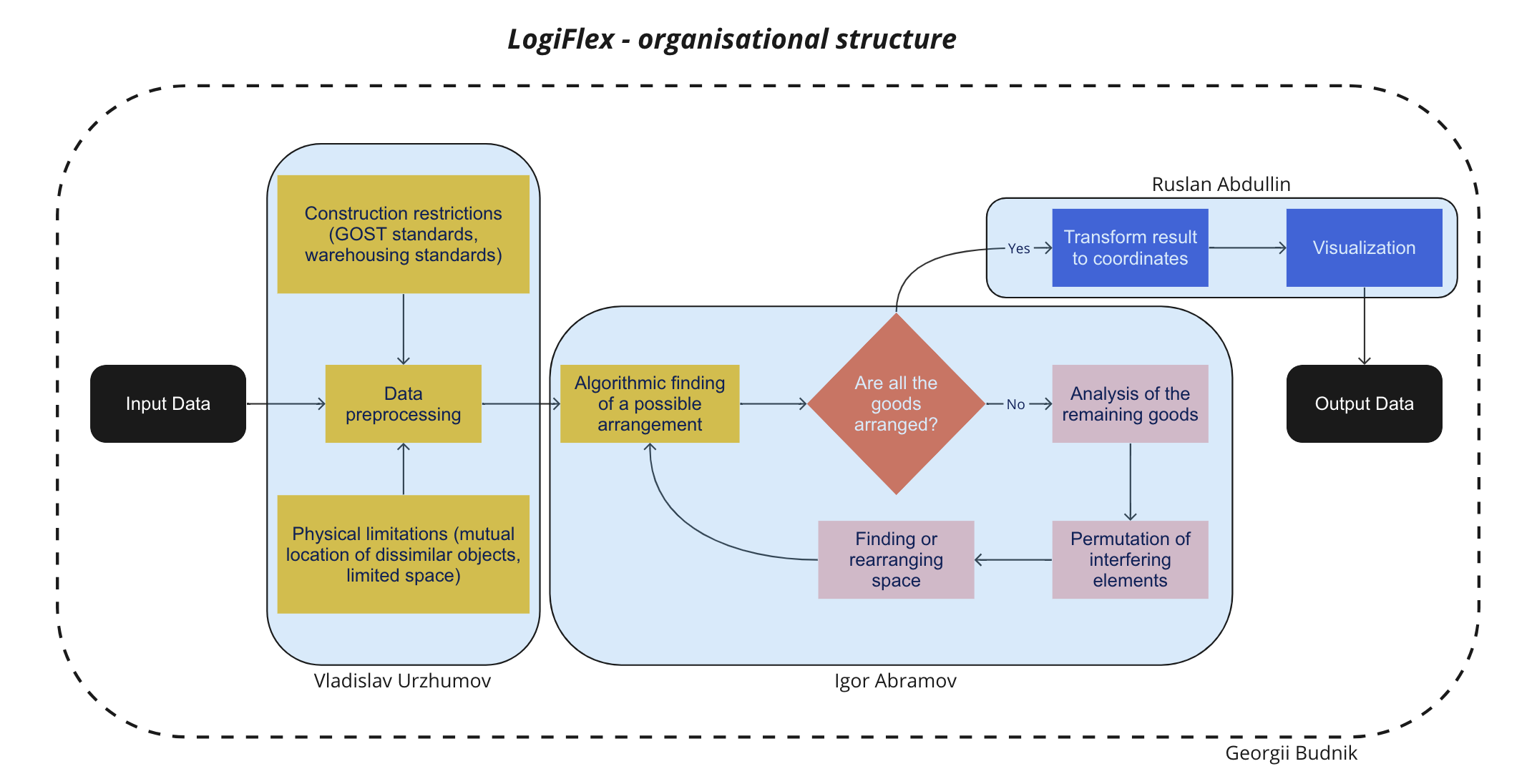
Feedback I like the chart. It’s good that you have clear project task allocation and defined responsibilities for each team member
The initial information from the Terms of Reference was obtained, and the team discussed hypotheses regarding the data and its preprocessing. A data parser was developed to convert the JSON format data into a 3NF-dependent CSV extension database format, making it easier to work with the data. The team also started studying physics engines suitable for simplifying the task, exploring 3D data visualizers, and delving into scientific literature on logistics theory in a limited space of three-dimensional objects.
Tech Stack and Team Allocation #
The team consists of four members, each assigned to specific roles and responsibilities:
- Georgii Budnik: Lead of the project responsible for management tasks, business process administration, and communication with the customer.
- Igor Abramov: DS Specialist focused on the mathematical apparatus, research, and algorithm development.
- Vladislav Urzhumov: ML Engineer responsible for algorithm implementation, data analytics, and preprocessing.
- Ruslan Abdullin: Developer-Visualizer in charge of visualizing the algorithm’s results and adapting them for production.
The team members’ roles are combined, and they work together collaboratively. The payment structure is based on the overall results, which fosters a sense of shared responsibility and drives progress.
Agile principles are implemented in the project management process. The team has fixed time slots for task distribution, collaborative work, and error fixing based on previous iterations.
Tech Stack Resources #
The team relies on a strong knowledge base to tackle the project’s scientific and technical challenges. They use articles from platforms like Habr, Arxiv (by Cornell University), Elsevie, and other scientific libraries for research purposes.
Their practical skills and knowledge are primarily acquired through educational courses at Innopolis University and other open educational platforms such as Google and MIPT. The team’s hypotheses and approaches are based on this knowledge and are tested iteratively. Their theoretical and practical understanding is continually strengthened, allowing them to plan their work effectively.
For example, thanks to several scientific articles about genetic algorithms this week, we concluded that we should not use this approach, since such algorithms can give 100% results, but they lose very much to other methods in time: in our case, each truck would be unloaded for 9000-15000 minutes, which is unprofitable.
Feedback Have you looked for companies with similar business goals? Logistics optimization seems to be a very important part of large scale companies. Find and study best solutions available globally
Mentorship Support #
The team has agreed to receive mentoring from the customer, maintaining constant communication with Alexander Filippov, the head of the company’s IT department. This collaboration provides access to real input/output data, enables communication with movers and drivers, offers insights into standardized limitations, and allows for modifications and clarifications to the terms of reference, which positively impact the team’s progress.
Feedback Very good, getting feedback from the customer will help to steer your project in a proper direction
Exploring Alternative Resources #
The team is exploring alternative resources to support their project. One area of focus is physical engines for simulating physical space, such as Unreal Engine or Unity. They are also considering self-written open-source physical simulators. Understanding how physical interactions between objects are implemented helps enhance their understanding of object interaction and the challenges posed by heterogeneous building materials in a cargo transport complex.
Additionally, the team is studying simulators of physical space for data visualization. They initially relied on classical Python libraries but realized the need for higher-level 3D visualizers. As a result, they are currently studying literature on 3D-cuboid-packing to enhance their visualization capabilities.
Each stage of their work has specific nuances that require study to ensure the stability and effectiveness of their commercial algorithm. Extensive scientific literature in the logistics field provides valuable insights and guidance.
Identifying Knowledge Gaps #
Given the advanced nature of the project, the team has identified three key knowledge areas that require further exploration:
- Harmonic algorithms for packing d-dimensional cuboids in a limited space
- the Theory of interactions of heterogeneous objects
- Advanced heuristic algorithms for the optimal arrangement of elements in a limited space
These knowledge gaps need to be addressed to develop efficient and effective solutions.
Engaging with the Tech Community #
The team actively participates in online discussions on forums related to their field, particularly under articles or scientific papers. They plan to attend local meetings in Kazan and Innopolis, and they are considering holding a mini-presentation of their product to attract additional investment and interest from Innopolis University and local technoparks.
Learning Objectives #
During Week 2, the team received real input data from the customer, and they developed a data translation parser in JSON/CSV formats. They also obtained answers to their questions, allowing them to start developing a mathematical apparatus for simple logistic combinations of objects. They concurrently studied scientific articles on more complex cases.
Sharing Knowledge with Peers #
Communication and knowledge sharing are crucial in the project. The team has established official and local social groups for communication. They have allocated collaboration slots every week to distribute tasks, discuss progress, and address errors. The rest of the time, team members work independently but maintain online communication.
How have you leveraged AI to compensate for any lacking expertise in your tech stack? #
The team recognizes the value of AI in their project in two main aspects:
They rely on AI algorithms used in d-dimensional logistics devices for object placement. This knowledge helps them envision the potential results of their own program. Language models like ChatGPT, such as the one they are using, assist them in complementing ideas, highlighting important aspects of their work, and saving time. By leveraging AI capabilities, the team enhances their problem-solving and idea generation processes.
In conclusion, Week 2 marked significant progress for the project. The team delved into the scientific aspects, obtained real data, and began developing a mathematical apparatus for logistic combinations of objects. They established a well-structured team and implemented Agile principles to enhance collaboration and productivity. Mentorship support from the customer provided valuable insights and helped refine the project’s goals. The team actively explored alternative resources, such as physical engines and data visualization tools, to enhance their understanding and capabilities. They identified key knowledge gaps that need further exploration. Engaging with the tech community and sharing knowledge with peers are ongoing priorities. Leveraging AI algorithms and language models proved beneficial in envisioning outcomes and optimizing their work. Overall, Week 2 was productive, laying a strong foundation for the project’s continued success.
Feedback Overall, I think this week progress report is well written and covers all aspects outlined in the weekly task. It is also good to see that you and your team is working overtime to tackle all possible problems. Good project handling is evident - 5/5 for the week
Week Three #
Progress report - Week 3 #
Agenda:
- Weekly Progress Report
- Prototype development
Weekly Progress Report #
In Week 3, the team focused on developing a prototype and addressing critical points in the theoretical solution proposed in the previous week. Each developer conducted research work and practically solved a subtask from the main project.
The team received a general upload of data from the customer’s 1C database. Preprocessing was implemented to filter the nomenclature names and mandatory physical characteristics of the data for solving the logistics problem. Several algorithms have been developed for stacking objects without taking into account their physical interaction and visualizations have been created for them.
External resources were utilized, including employees from the Technopark who had experience with “cleaning” big data. The team also reached out to Kevin Handa from the guest sector to ask clarifying questions that could potentially contribute to the project’s further development.
The prototype’s performance was tested on a basic example, showing significant improvement in the optimization of space utilization compared to the classical approach. Overall, it was a productive week with a focus on implementing AI in the project.
The purpose of creating a LogiFlex prototype #
The key task that the team faced this week was to assess the global situation:
- “Is it possible to do everything from what is planned?”
- “How much do you need to accelerate?”
- “How to distribute the remaining subtasks more efficiently?” To achieve this, the team added additional subtasks to their schedule to create a Minimum Viable Product (MVP) and obtain answers to their pressing questions.
LogiFlex prototype: visualization #
The first step in the prototype development was creating a visualization of cuboids. Cuboids were chosen as a representation for small goods to simplify the process. The initial visualization looked like the following:
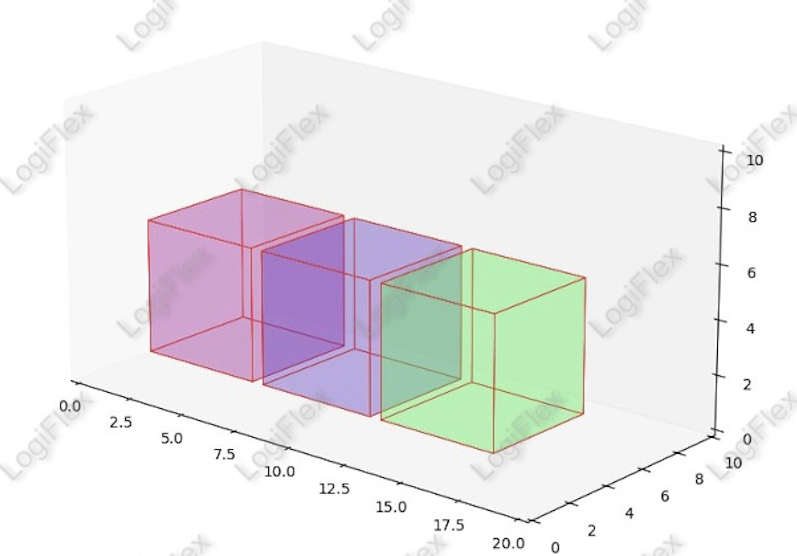
To visualize more complex objects in the future and describe them effectively, the team considered using the Gazebo simulator, which they already had experience with. This choice would potentially enhance the quality of visualization.
LogiFlex prototype: framework development #
The team implemented a space where they could set the initial values of a cargo vehicle, the number of cuboids, and their dimensions. Since visual display of the delivered objects would allow for an instant assessment of the algorithm’s quality and the resulting placement of goods, the team combined the framework development with the visualization step, resulting in the following outcome:
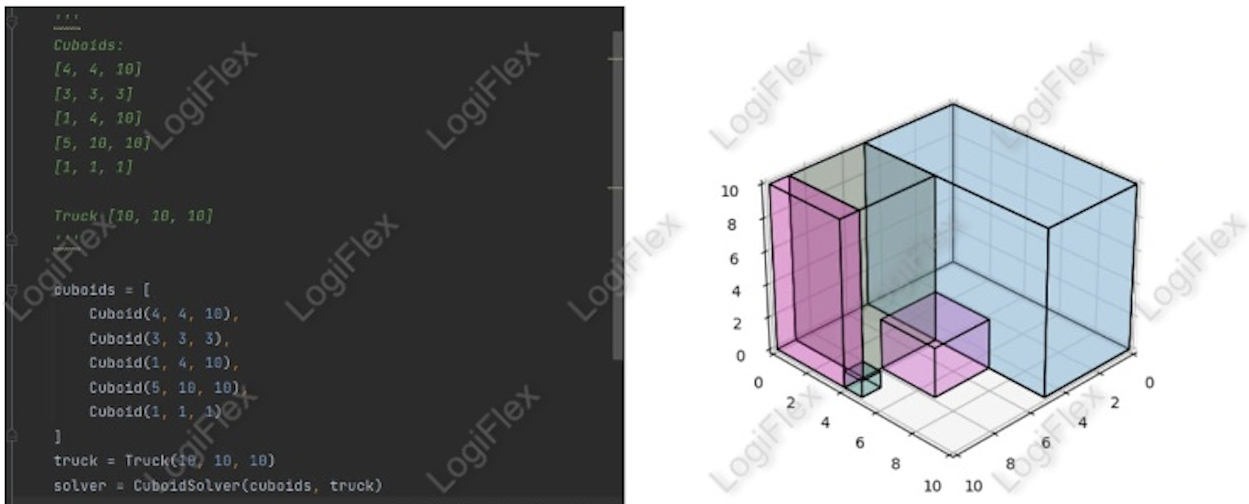
To test the functionality of the framework, a classic algorithm based on dynamic programming was developed for stacking goods. The algorithm aimed to place the largest product in one of the far-left corners, with multiple corners available if the truck was at least partially filled.
LogiFlex prototype: Optimal algorithm development #
The final and crucial step in the prototype development was to enhance the optimality of object placement. After considering several options with the customer, the team decided to use the ratio of the total volume of the put cuboids to the minimum bounding cuboid as the optimality index. This ratio demonstrated the maximum utilization of the remaining space.
Among various AI algorithms, the genetic model yielded the best balance between time spent and expected quality.
It’s important to note that due to LogiFlex being a commercial project, the team cannot share the solution or any specifics as all copyrights belong to the customer.
After training on most of the input data, we decided to compare our algorithms on a basic example to check the convergence of calculations.:
Suppose we have a finite space with dimensions 10x10x10 and an infinite number of arbitrary elements from our list of arbitrary dimensions (the order and dimensions of the elements for both algorithms are the same).
The result is in front of you:
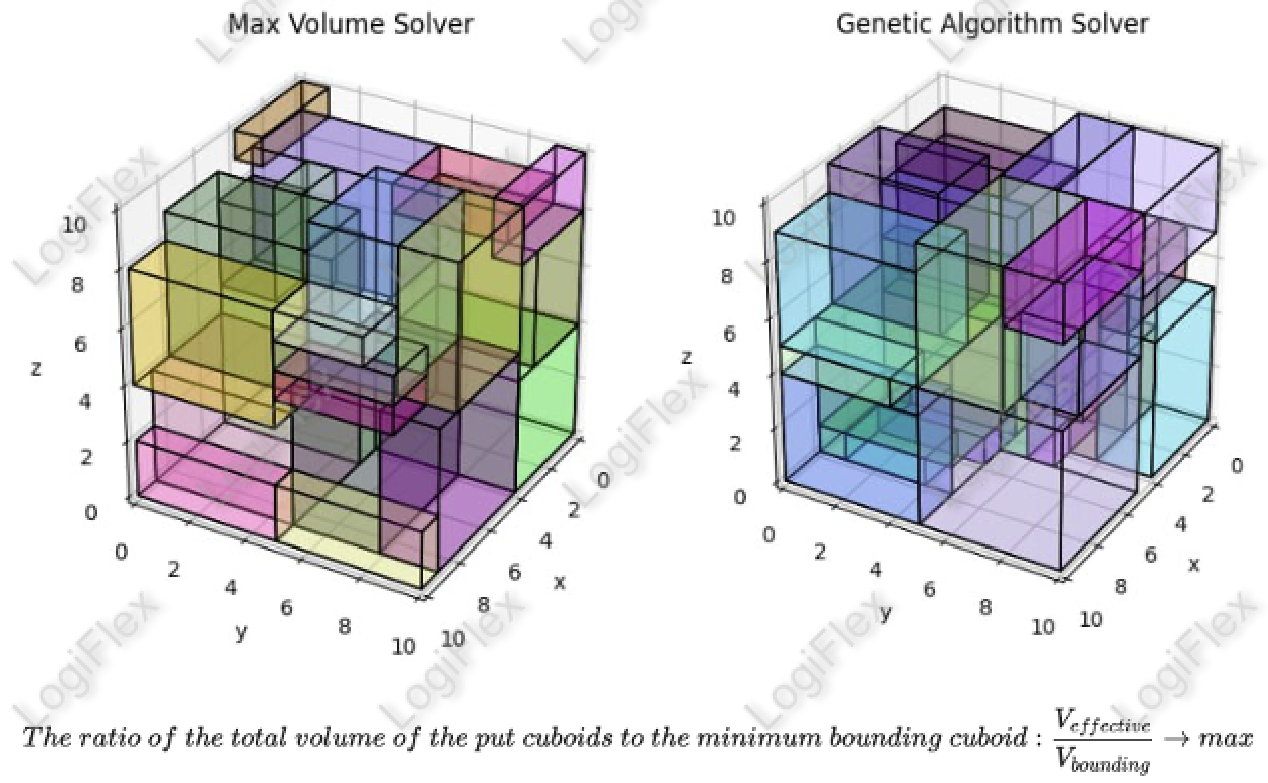
The results showed that the classical stacking approach occupied 73% of the space, while the genetic solution achieved an occupancy of 92%! Our optimization is 19%. We believe that this is a successful indicator, since it could save (taking into account the statistics of our case) about 20% of product turnover per day, which is a great advantage for the company.
Such a result gives an incentive to dive deeper into the subject of AI application and place great emphasis on algorithms in this area in the future.
Drawing conclusions about the past week, we can conclude that this is one of the most productive weeks in terms of implementing AI in our project. We can’t say that everything went perfectly - we wanted to develop two AI algorithms in total, but due to insufficient knowledge, we were not able to do it in full. There were a lot of difficulties with data processing, for which we lost a lot of time, because of which half of the team did not have time to complete individual tasks before the sprint closed.
Nevertheless, work was done on the prototype, and all critical points were checked. It remains only to continue in the same spirit, analyze the errors that arise and try to solve them more quickly.
Week Four #
Progress report - Week 4 #
Agenda:
- Weekly Progress Report
- Iterative approach to work
- Product testing & refinement
Weekly Progress Report #
During Week 4, the team focused on addressing specific challenges and refining the product based on real-world scenarios and input from various stakeholders. The main difficulty of the problem lies in the fact that there is no specific list of restrictions that the algorithm should take into account, so we decided to solve a similar problem based on everyday experience. More precisely, the experience of various “effective” employees who faced similar tasks in a “manual” format.
Eight meetings were conducted with managers responsible for different categories of goods, and a final meeting was held with the head of the company for commerce and retail and the head of the IT department. These meetings helped gather insights and agree on the final features and technical aspects of the project.
Based on the meetings held, we compiled a weekly list of tasks that was successfully completed:
It’s important to note that due to LogiFlex being a commercial project, the team cannot share the solution or any specifics as all copyrights belong to the customer.
- Development of the technology for the mutual arrangement of goods: The team worked on creating a technology that takes into account various factors such as mass, volume, type of packaging, and more to determine how different goods (~14'000 elements) can be placed together. A table was derived based on statistical, arithmetic, and empirical methods, as well as knowledge of loading goods. The table includes 14 groups, with rows representing the type of goods that an object can be placed on, and columns representing the type of goods that can be placed on top. The table uses symbols to indicate whether it’s possible to put the goods (1), impossible to put the goods (-1), or it depends (0). The final agreed table looks like this:

- Accounting for the distribution of masses of goods: To ensure the balance of goods in the truck and avoid accidents, the team worked on analyzing and visualizing the distribution of masses of goods. The visualization of the analysis is in front of you:
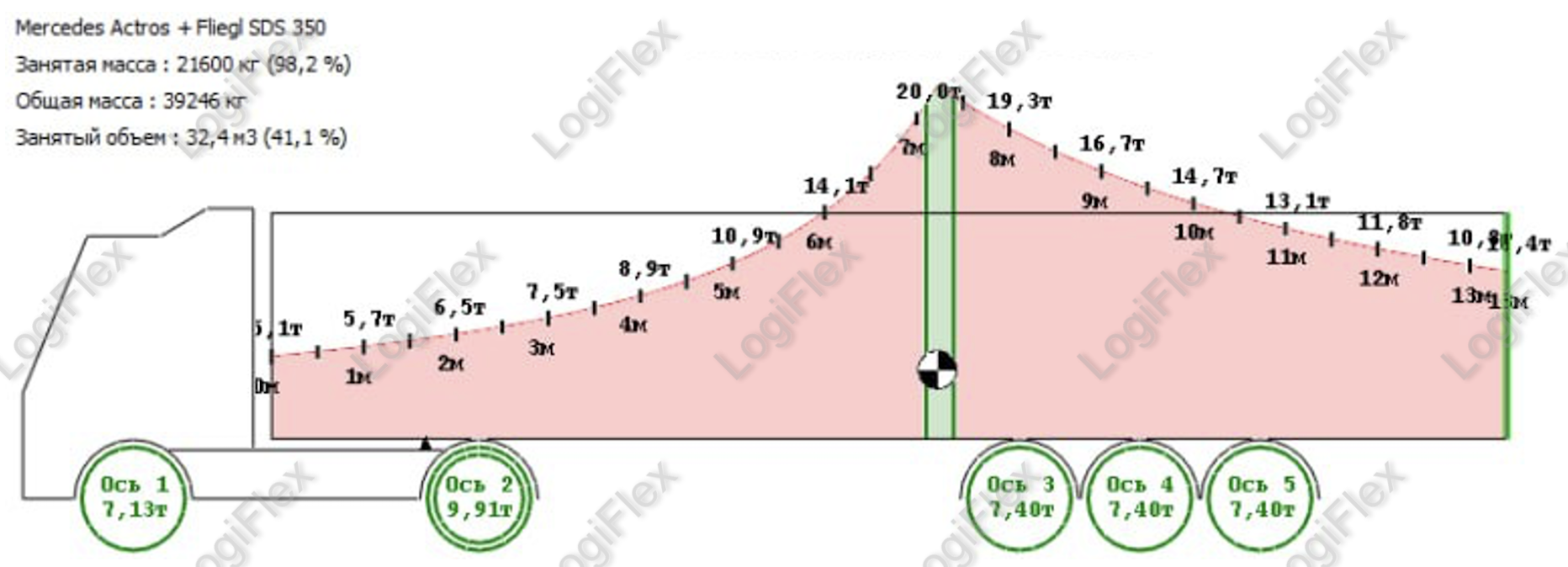
Development of an optimal data parser: An optimal data parser was created, which uses regular expressions and manual settings to extract necessary information about the products, even if the data structure is incomplete. The program automatically detects “insufficient” information and moves such goods to a separate file for manual addition of missing data.
Verification and integration of previous items: The team verified and integrated all previous items (except the first one, since we decided to bring the next week to it). The product demonstrated its capability from the state “Received the order list” to “Displayed the image” (A small “flying” red cuboid is the center of gravity of the cargo. It is correct):
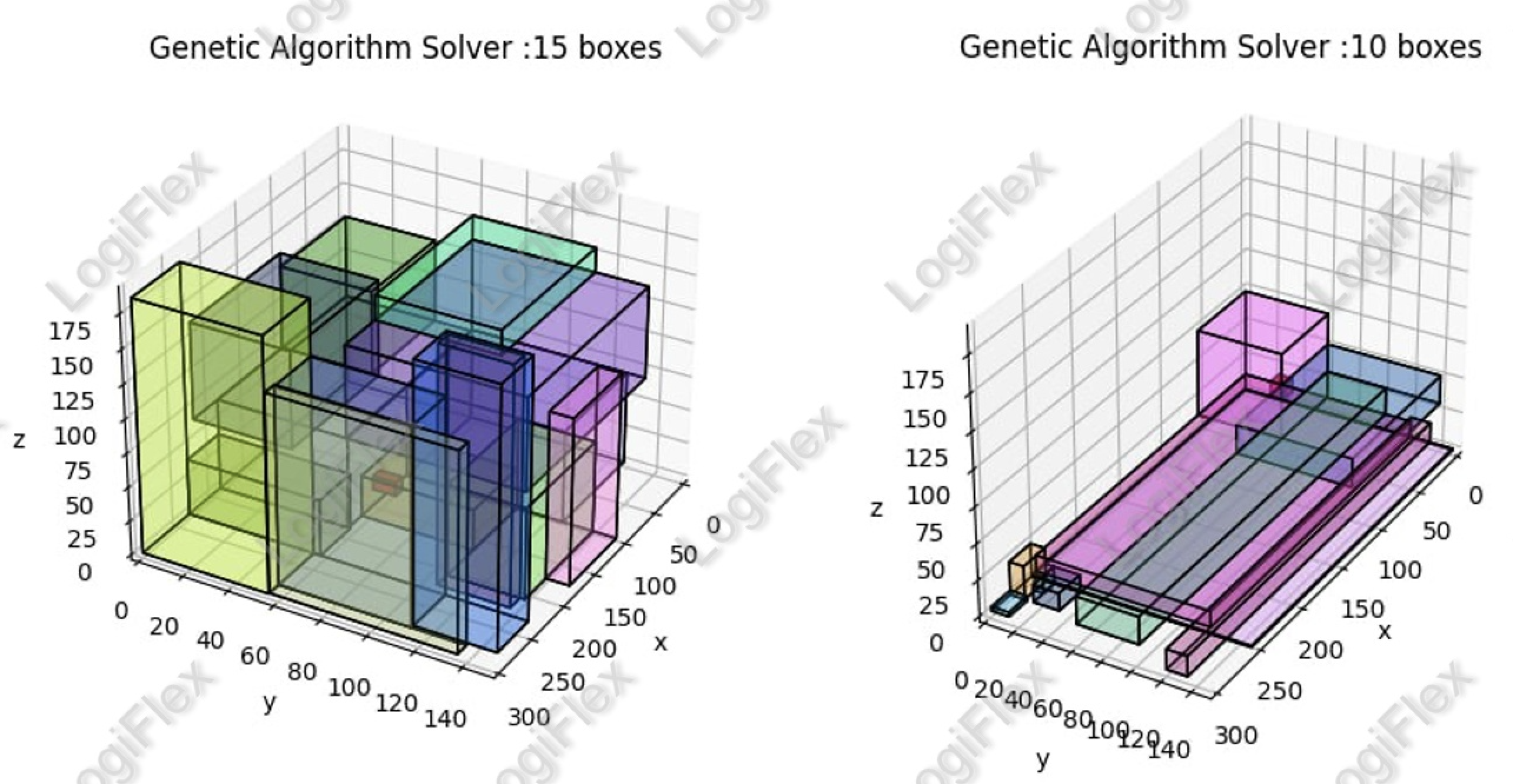
Iterative approach to work #
The team adopted an iterative approach to their work, allowing them to work efficiently and produce results. Regular meetings were held with company employees, and new data was continuously revised and accounted for in the updated product features. This iterative approach was applied at different levels, including weekly work, team collaboration, and process improvement.
If we look at it globally, but the iterative approach is used by us everywhere, simply, in different manifestations: in understanding weekly work, working with part of a team or imposing a process.
Product testing & refinement #
Several product testing methods were employed by the LogiFlex team. Initially, they collected feedback from friends and acquaintances to gather diverse perspectives on the product/idea. As the development progressed, the team narrowed down their focus group and currently communicates with mentors and executives who evaluate and provide feedback on their work.
Continuous communication with the head of the customer company’s IT department ensures that the team incorporates their vision and refines the product according to the requirements of the final consumer. While the current stage of development limits extensive testing due to copyright restrictions, the team plans to conduct further testing once the product is finalized and released.
The fourth week can definitely be called the most mundane (of those in which the product was developed), since its goal was to adapt the theoretical code based on researching into the technology used in different ways. A lot of improvements were carried out, which more clearly formulated the customer’s requirements, which were lacking before.
This week was also the most unstable - one of our participants in our work fell ill and took a week’s sick leave (for a team of 4 people, this is a strong subsidence in terms of potential effectiveness - ~25%). Also lead of the project had a business trip for the entire second half of the week. (the same ~25% of potential losses). Thus, for a whole week, the team has never gathered in full. Nevertheless, thanks to everyone’s responsibility and team cohesion, work has been done that will definitely come in handy in the coming weeks.
The next week will be devoted to the formation of a single file with the code that will perform all planned iterations, as well as the digitalization of the technology of the mutual arrangement of goods.
Week Five #
Progress report - Week 5 #
Agenda:
- Weekly Progress Report
- Final presentation preparation
- Regular feedback and further development
Weekly Progress Report #
Since product development and project implementation are coming to their logical end, the fifth week for our team meant structuring and highlighting the boundaries of work agreed with the customer. And also, the allocation of increased attention to the tasks that the customer has designated as paramount.
Our week began with a meeting and feedback from Alexander, the head of the IT department of our customer, as a result of which the boundaries indicated above were formed. All the remaining points and moments were divided into tasks (evenly relative to the value for the customer) and presented in the form of a workspace:
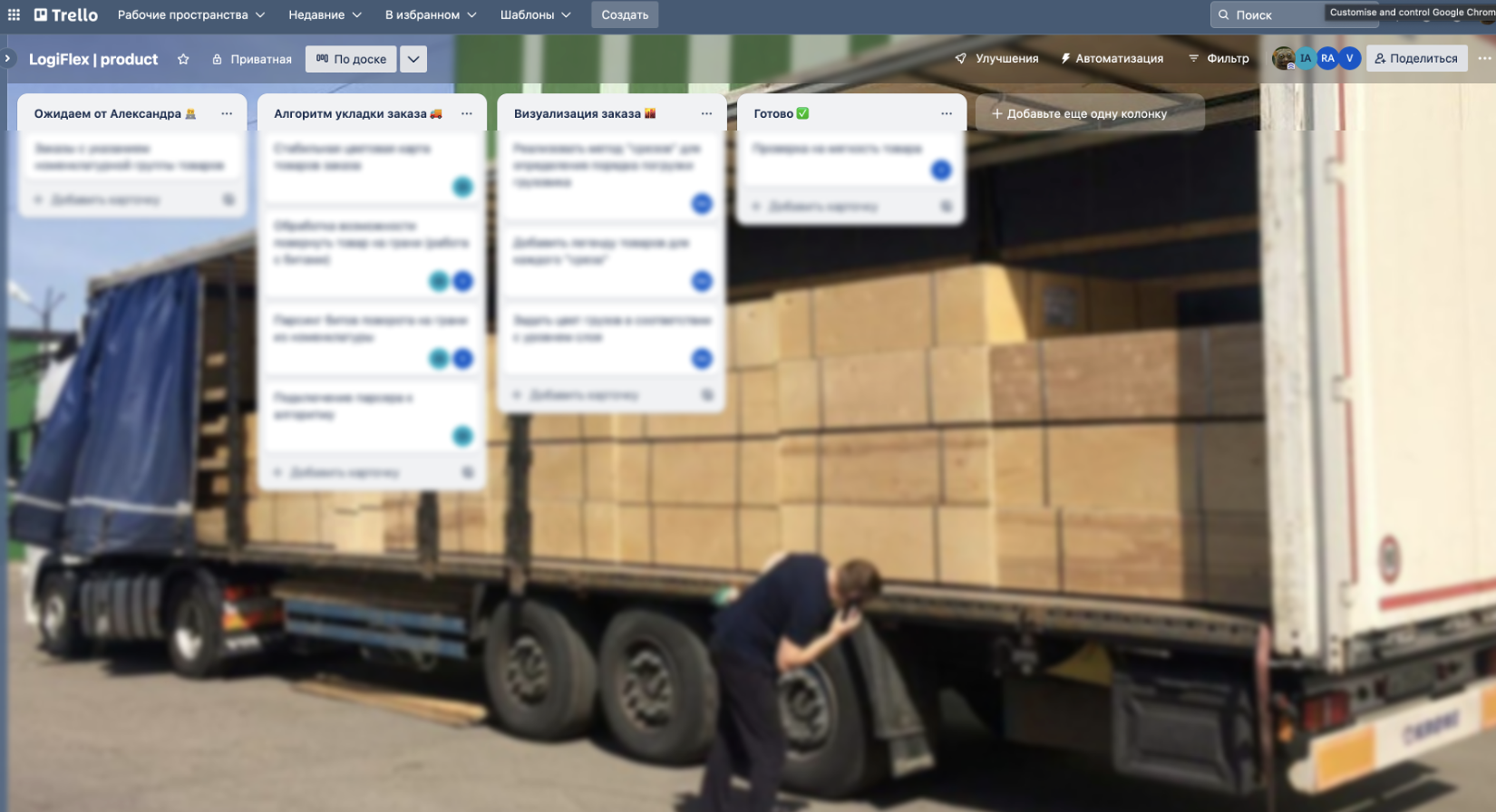
It’s important to note that due to LogiFlex being a commercial project, the team cannot share the solution or any specifics as all copyrights belong to the customer.
During the fifth week, most of the tasks were completed, but this does not mean that there was little work left, since only the priority tasks necessary for further work were completed, and the rest was postponed to the sixth week. Roughly speaking, it can be said that the completion of all tasks on the blackboard means the end of paid work.
Mainly, the tasks related to the construction of a more detailed structure and the case of non-standard location of objects, even taking into account the many existing restrictions.
For example: a toilet bowl, as a commodity, has sufficiently high indicators of fragility, but it is delivered in rigid sealed boxes, which allows you to put quite heavy objects on it (~40% of the total weight of the toilet bowl can be put on it). BUT, since it is delivered disassembled (main part + drain tank + lid + mechanism), it needs to be supplied to provide additional safety conditions and reduce all shaking in the truck to a minimum. After consulting with the customer and logisticians, it was decided to always put the toilet bowl to the lower left/right corner as close as possible to the cab of the truck. But such an arrangement and additional conditions exclude the laying of additional goods from above.
We have been dealing with such, literally, paradoxes of opportunities-anti-opportunities all week and were able to achieve a working result of non-standard layouts for most products:
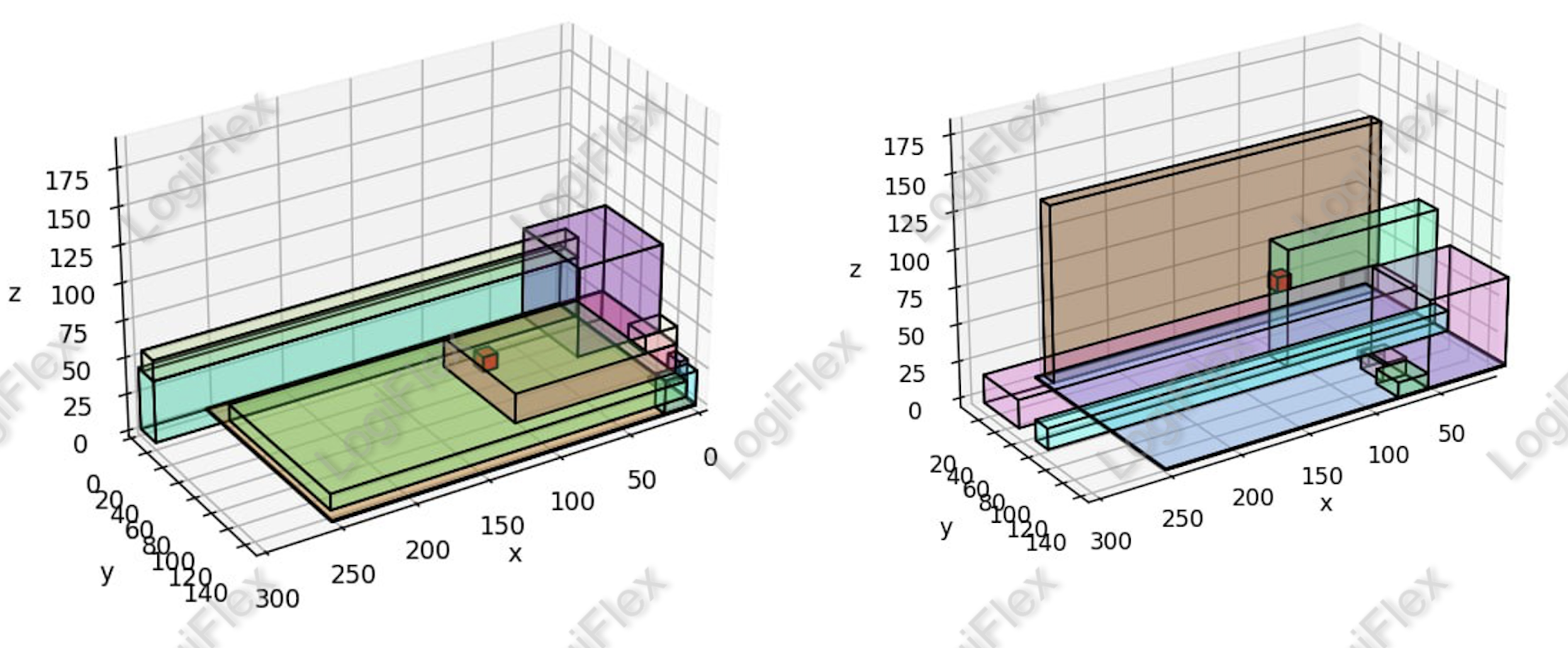
Above is an example of laying the same order without taking into account / taking into account non-standard cases of laying. According to the customer’s estimates, 85-95% of all theoretical non-standard situations were taken into account by us. The key thing that pleases us is that we managed to achieve such a result WITHOUT losing capacity on all text orders.
The team also made significant advancements in data visualization and animation. A legend of the order was developed, and the sequence of laying goods, along with their interactions, was visualized. Slide animation of the layout was implemented to demonstrate the results effectively:
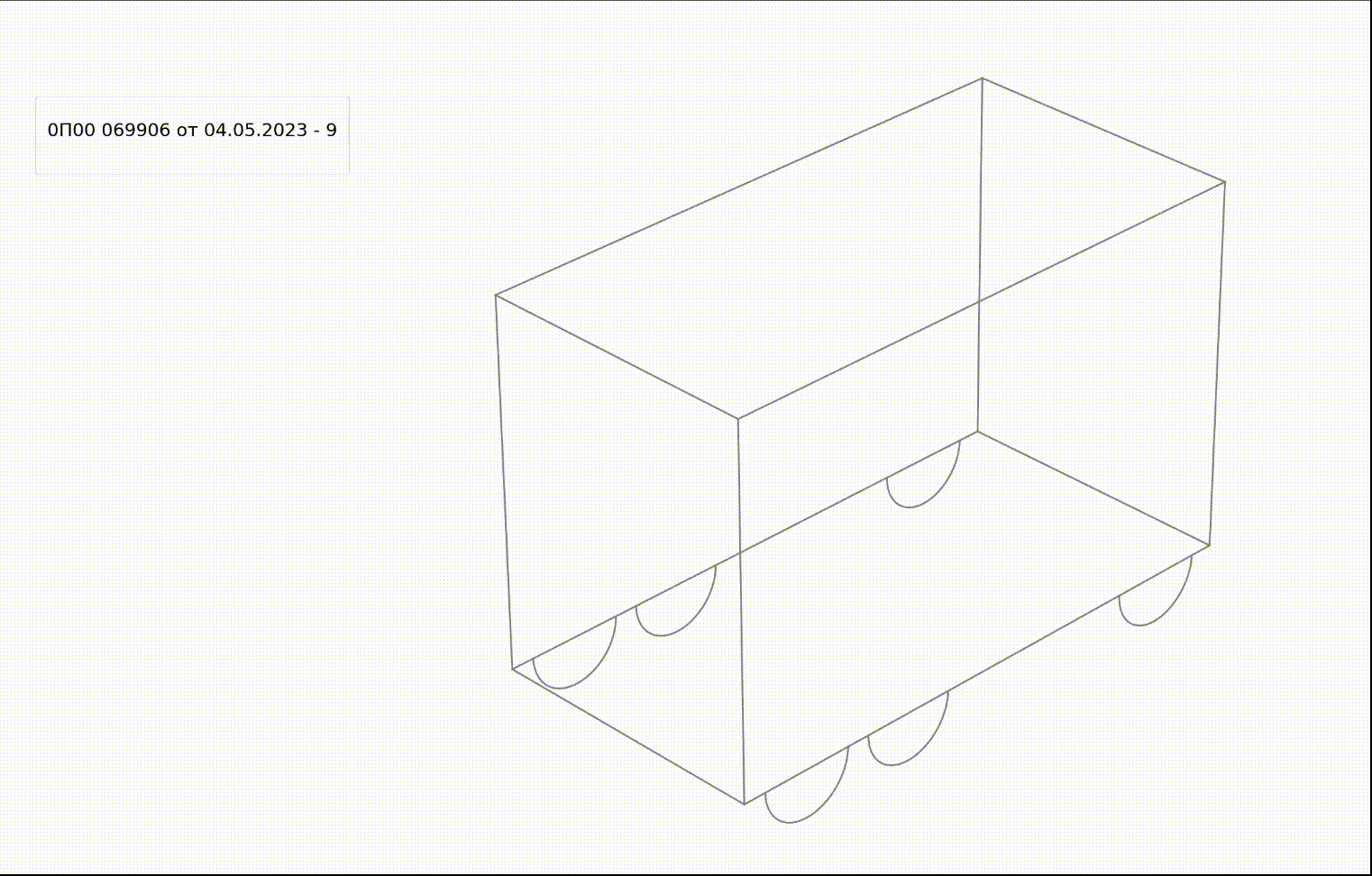
This result was achieved due to a well-written and structured parser, which initially supplied values in “pure form”, which greatly simplified and at the same time increased the efficiency of work.
Final presentation preparation #
Based on our extensive experience of public speaking, we immediately concluded that most of the perception of our work depends on the presentation, and as it seems at first glance on the work done.
Therefore, touching on this topic a little deeper, we began to develop an approximate speech plan and even tried to speak at one of the project defense sites to try to assess our strengths, highlight weaknesses. The recording of the 15-minute speech can be viewed here.
The presentation of the project, the speaker and the format of the speech have not yet been finalized, since the main task was to try to speak and convey to the audience the key information of the project, motivating them to learn more.
Based on the results of our presentation, we can conclude that the main idea was conveyed, but we need to make a greater bias on the ability to explain the work itself, showing it on the one hand complex and voluminous, but not to go into confusion and an unsurgmented strategy of “proving” the solution to our problem.
In general, such experience was useful and showed our strengths and weaknesses during the defense of the idea, a brief explanation of the principle of work, as well as the design of our results.
Regular feedback and further development #
The LogiFlex team greatly valued regular feedback from external sources, including the head of the customer’s IT department, colleagues, and friends. While collecting statistical feedback would have been useful, the team focused on informing and exploring different approaches to stacking goods due to time constraints and uncertain tasks. Feedback and opinions played a significant role in shaping the final vision and product.
Our product does not need statistics or feedback directly. Of course, this would be useful, but in view of the limited amount of time and a large number of uncertain tasks, the decision was made based precisely on informing and thinking about different approaches to stacking goods. Unfortunately, we cannot disclose some of the subtle details of our work, but believe me, feedback and opinion have greatly influenced our final vision and product.
Also, this week a record number of meetings were held (after the transaction) with the CEO of the customer company - 3 pieces. The head of the company shared his vision and further development of this project.
As a result of numerous discussions (both with the customer and with people who have no connection with the project), we began to form further ideas for the development of our product:
In the customer company, our developments and understanding of the stowage of goods can be used not only in cargo vehicles, but also in warehouse areas. This approach will make it possible to build an already efficient ecosystem of cargo transportation, which can increase efficiency by another 12% according to our approximate calculations! (i.e., the overall efficiency of work relative to the current moment may increase by 35% or more).
Another aspect of further cooperation is the mutual stacking of goods between different trucks, taking into account their route maps. Such a thesis expands the mathematical problem that we have already solved, making the problem multifaceted. Also, it can increase the efficiency of work several times.
To complete improvements and unexplored algorithms. The most obvious, but effective method. The customer company, inspired by our results, became interested in further employment of employees in the state, which may be possible with the successful completion of the current project.
Obviously, this is only a small piece of what can be done with a really working product. Nevertheless, the beginning of planning for further development has been laid, and the main thing is that there is interest on both sides in this!
Week 5 marked the narrowing of the work scope and the completion of tasks such as the data parser and the main algorithm for stacking goods. These parts were officially accepted by the customer, and the focus shifted towards preparing the final presentation and visualization of data. The upcoming week is expected to be busy as the team balances the desire for further enhancements and the need to conclude the project. The team looks forward to the final defense in two weeks.
Week Six #
Progress report - Week 6 #
Agenda:
- Weekly Progress Report
- Visualization of result
- Final presentation
Weekly Progress Report #
Despite the fact that the sixth week mainly concerned the completion of the work done on the course, the LogiFlex team was in full swing implementing new modifications and features of the product packaging algorithm.
First of all, a re-collection of all tasks and improvements that had not yet touched (at that time) the algorithm was carried out. For example, visualization of cylinders and “stacking” of homogeneous goods. This and much more was implemented at almost four additional meetings this week. All tasks were recorded in the already used workspace:
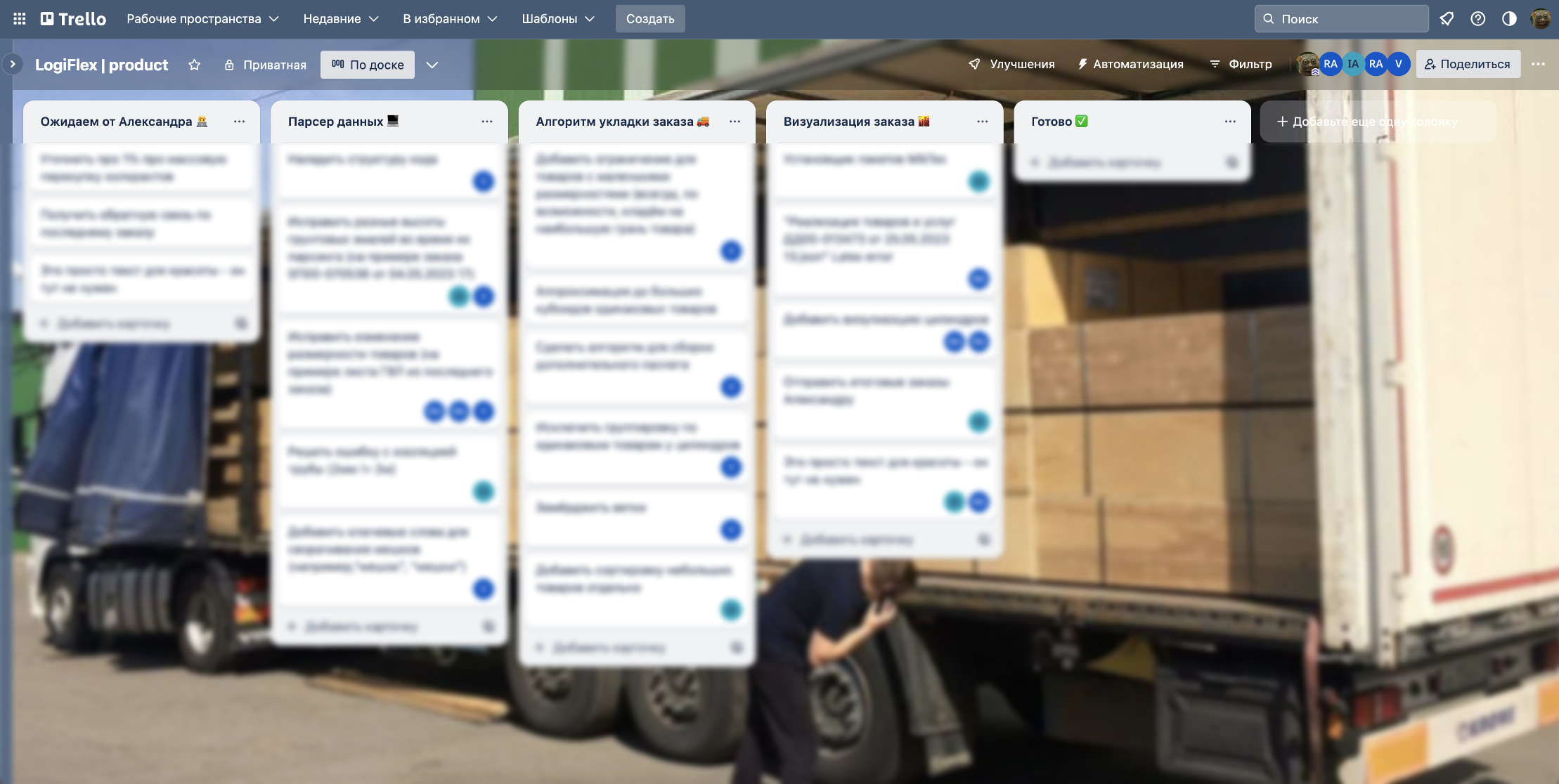
It’s important to note that due to LogiFlex being a commercial project, the team cannot share the solution or any specifics as all copyrights belong to the customer.
Each task was worked out and redone several times, which made it possible to achieve a more specific vision of the product in detail. It cannot be said that this was a mandatory job, but it will definitely help us to continue to cooperate with the customer, which is in our opinion a very wise step.
Visualization of result #
The visualization aspect of the project reached its finalized state. The layout of “emerging” orders, adaptation to different screen sizes, and internal functions for deploying the interface to various devices were completed.
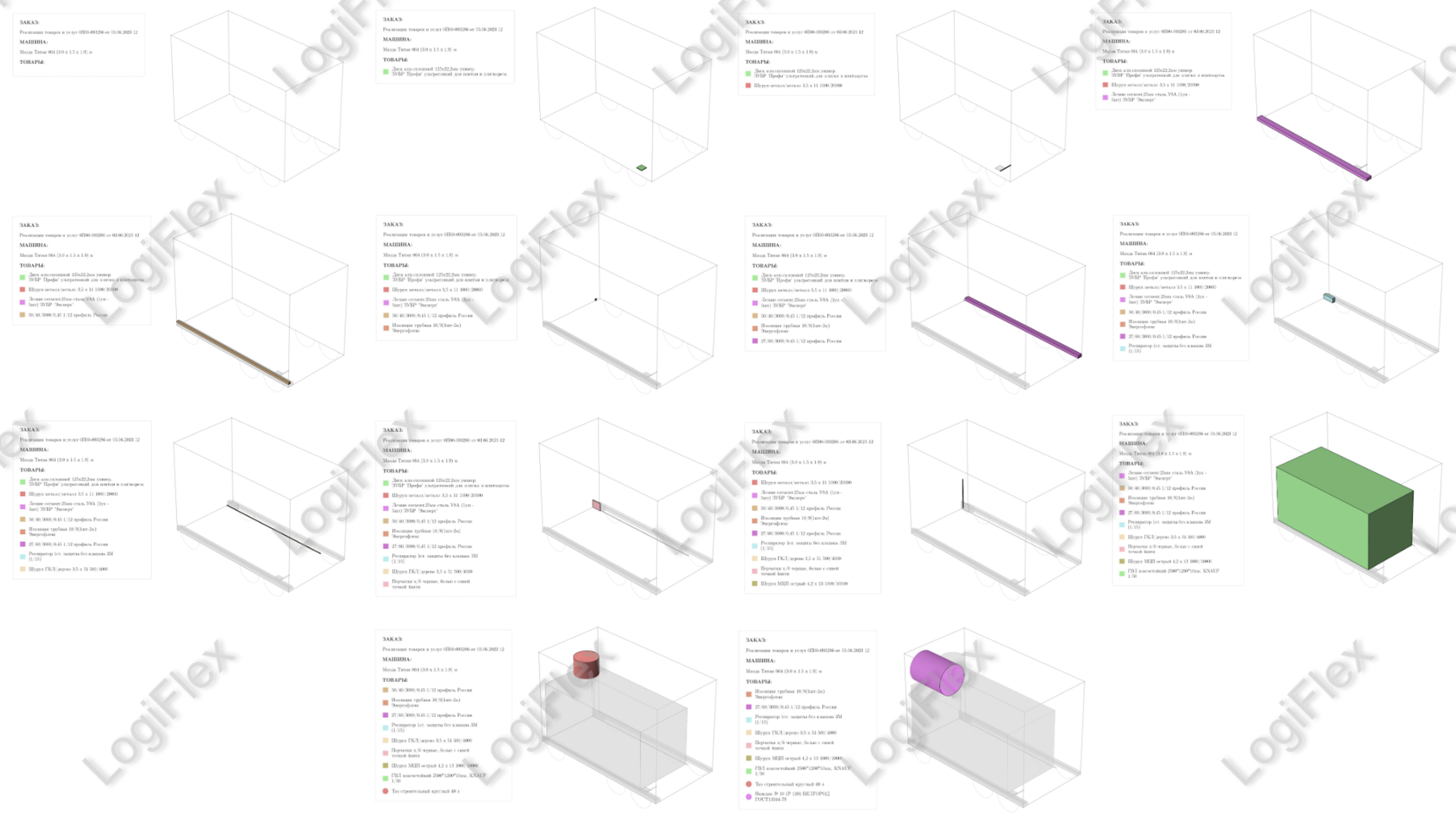
The final visualization includes a pool of completed tasks and presents the results of the algorithm in the form of an instruction. The instruction features a color palette, intuitive symbols, and displays additional information, providing a comprehensive view of the packaging arrangement.
Final presentation #
The LogiFlex team developed a comprehensive presentation that showcases the progress made over the course of 6-7 weeks. The presentation highlights the project’s significance and serves as the first impression of the work accomplished. The team prioritized the value of the presentation and aimed to convey the progress and achievements effectively.
Week 6 represented a motivating final push to complete the tasks, despite delays and challenges encountered in previous weeks. The team successfully completed the assigned tasks and expressed confidence in the market demand for the LogiFlex project.
Such experience of work and collaboration has shown that the algorithm of optimal arrangement of heterogeneous goods is relevant in the market and further development of LogiFlex will definitely go beyond the student course.
Alright, reports are good, as usual. Liked the data visualizations. Please upload the final presentation to the top of the file. 5 for both weeks